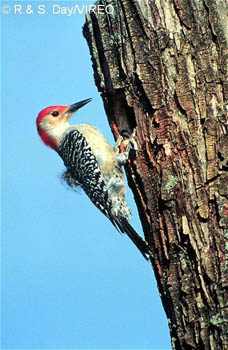Loading ...
Red-bellied Woodpecker
The Red-bellied Woodpecker (Melanerpes carolinus), is named for a reddish tinge on the belly. Ironically the red on the belly is rarely observed. It is medium-sized, handsome woodpecker with black-and-white barring on the back and a bright red cap. It commonly visits suet feeders in winter. This bird, as its species name indicates, has its roots in the southeastern United States though in the 20th century it has extended its range north and west. It is now a year-round resident throughout the eastern half of the U.S.. The Red-bellied is a conspicuous early nester, starting its breeding cycle in February by drumming on a dead tree stub, excavating a nest cavity, and loudly proclaiming "chwirr, chwirr, chwirr". The Red-bellied Woodpecker also occasionally calls "chivv, chivv, chivv", a husky sound somewhat like the starting of an antique car engine.
See all Red-bellied Woodpecker photosField Marks:
The Red-bellied Woodpecker has buff-gray under parts, a red cap extending from nape to bill in the males but short of the bill in females, and black-and-white barring on the back. (L. 9.25 in.)
Distribution:
The Red-bellied is a permanent resident of the eastern U.S. from Kansas to the Atlantic Ocean and from central Minnesota and Massachusetts to Florida. Individuals migrate seasonally within this range.
Similar Species:
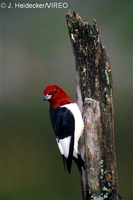 |
Red-headed Woodpecker (all photos) The uncommon Red-headed Woodpecker has a solid black back and large white patches on the wings and rump. |
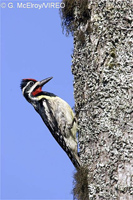 |
Yellow-bellied Sapsucker (all photos) The Yellow-bellied Sapsucker is a smaller bird with a longitudinal white stripe on the wings, a black-and-white striped face, and a red crown and throat (in the male), but no red on the nape. |
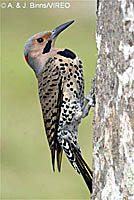 |
Northern Flicker (species account) (all photos) The Northern Flicker has a brown-and-black barred back, a gray head with only a sliver of red on the nape, and a black-spotted breast. |
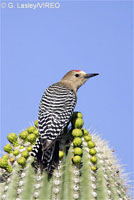 |
Gila Woodpecker (all photos) The Gila Woodpecker has a tan (not red) nape and a barred rump. It is only found in the desert Southwest and adjacent Mexico. |
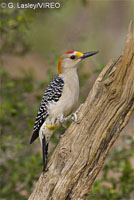 |
Golden-fronted Woodpecker (all photos) The Golden-fronted Woodpecker has a orange-yellow (not red) nape and a white rump. It is only found in western Oklahoma, Texas and adjacent Mexico. |
Habitat & Nesting:
Red-bellied Woodpeckers use a variety of woodland types and do especially well in large deciduous trees and swampy bottomlands. In the South its preferred habitat is pine woods. It excavates slightly oval, 2 -inch holes (the Pileated Woodpecker's holes are elliptical and larger), and often more than one hole is drilled in a dead tree or stub. The Red-bellied is sometimes ousted by the Northern Flicker.
More Information:
Like other woodpeckers, the Red-bellied Woodpecker has the undulating flight and the pointed and barbed tongue specially-adapted for probing tree holes and extracting insects. The bird's diet is varied: insects, nuts, seeds, berries, occasionally small lizards and mammals and even, in Florida, oranges. It stores or "caches" food..

